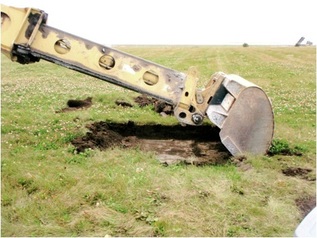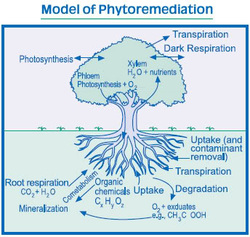Plant-assisted remediation of nitrogen fertilizer contaminated soil and groundwater at an industrial plant site
INTRODUCTION
Background and Rational

Remediation of contaminated soils and groundwater has traditionally involved operations such as excavation and landfill for soil, or pump and treat for groundwater. While potentially effective, these remediation strategies are expensive and often result in the transfer of environmental risk from the contaminated site to another waste management facility. In-situ remediation techniques such as phytoremediation and plant-assisted remediation have recently shown promise as less expensive alternatives to reducing the risk of environmental contaminants at impacted sites.
The research site is located at the Agrium fertilizer plant near Redwater, Alberta. Historical dumping of fertilizer fines and other wastes into a clay borrow pit on land adjacent to the North Saskatchewan River has resulted in significant ammonium, nitrate, phosphate and sulfate contamination of soil and groundwater in the area. This contamination has also resulted in increases in nitrate in sediment pore water on the western bank of the river. Despite a synthetic liner over the landfill area to reduce water infiltration, the groundwater table is high, and in some cases higher than the reported depth of the former landfill. Groundwater nitrogen concentrations range up to 24,000 ppm ammonium-N and 7000 ppm nitrate-N and impacts to the North Saskatchewan River remain a concern. Options for remediation and improving soil and groundwater quality must be investigated.
The research site is located at the Agrium fertilizer plant near Redwater, Alberta. Historical dumping of fertilizer fines and other wastes into a clay borrow pit on land adjacent to the North Saskatchewan River has resulted in significant ammonium, nitrate, phosphate and sulfate contamination of soil and groundwater in the area. This contamination has also resulted in increases in nitrate in sediment pore water on the western bank of the river. Despite a synthetic liner over the landfill area to reduce water infiltration, the groundwater table is high, and in some cases higher than the reported depth of the former landfill. Groundwater nitrogen concentrations range up to 24,000 ppm ammonium-N and 7000 ppm nitrate-N and impacts to the North Saskatchewan River remain a concern. Options for remediation and improving soil and groundwater quality must be investigated.
Research Objectives
The main objective of this research is to determine the effectiveness of four plant types in removal of nitrate and ammonium from fertilizer contaminated soil at an industrial plant site. Specific objectives of the research include determining which plant type is most effective in removal of the contaminants, and quantifying the upper limit of plant nitrogen tolerance.
Plant-assisted remediation is potentially very effective under conditions where soils are contaminated by high concentrations of a variety of plant nutrients, as well as being economical, sustainable and aesthetically pleasing. It is hoped that in addition to reducing the nutrient concentrations in the contaminated area, the plants will use significant amounts of water, thereby reducing water infiltration and the height of the water table.
Plant-assisted remediation is potentially very effective under conditions where soils are contaminated by high concentrations of a variety of plant nutrients, as well as being economical, sustainable and aesthetically pleasing. It is hoped that in addition to reducing the nutrient concentrations in the contaminated area, the plants will use significant amounts of water, thereby reducing water infiltration and the height of the water table.
Expected Results

It is expected that each of the four plant types selected for the study - alfalfa, Saltlander grass, Okanese poplar, and willow - will utilize the excess nitrogen salts in the soil. These plants are known to be high users of water and nutrients, and are relatively tolerant to stressful conditions. A difference in resistance to high nitrogen concentrations is also expected between plant types. The Okanese poplar and the Saltlander grass are anticipated to be the most resilient and to extract nitrogen from soils with the highest levels of contamination.
The results of the research project will be used by Agrium to develop plant-assisted remediation at many of their fertilizer facilities. The plant type that is determined most efficient in the extraction of nitrogen will be used at Agrium facilities in areas contaminated with excess nitrogen.
The results of the research project will be used by Agrium to develop plant-assisted remediation at many of their fertilizer facilities. The plant type that is determined most efficient in the extraction of nitrogen will be used at Agrium facilities in areas contaminated with excess nitrogen.
